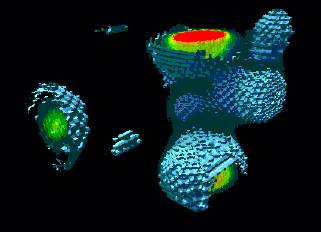PICTURING QUARK THEORY

|
The two types of quarks that combine to form protons and neutrons are the "up" and the "down." The up quark carries an electrical charge of +2/3 and the down quark carries a charge of -1/3. Since a proton consists of two ups and one down quark, its composite electrical charge is +1. Since a neutron is the combination of one up and two down quarks, it is electrically neutral.
Quarks are bound together inside protons and neutrons by the "strong" force which is carried by a particle dubbed the "gluon." Just as the electrical properties of their constituent quarks determine the overall electrical charge of protons and neutrons, so, too, are other properties, such as size and mass, believed to be the result of interactions between quarks and gluons. The theory that explains these interactions and enables scientists to predict the properties of protons and neutrons is called "Quantum Chromodynamics (QCD)."
According to QCD, quarks are so tightly bound by gluons that they can never be isolated as free particles -- a phenomenon known as "confinement." This phenomenon has made it so far impossible to test the predictions of QCD on particle accelerators. Scientists have consequently turned to numerical simulations using supercomputers such as those at NERSC.
One particularly promising effort involves a research group research group from Ohio State University. Working in collaboration with the Berkeley Lab's Visualization Group, this group is attempting to solve QCD problems by approximating four-dimensional spacetime with a discrete grid. Once the data has been imposed on such a grid, supercomputers can be used to produce valuable three-dimensional images of these four-dimensional problems.
This collaboration with Ohio State also includes the University of Washington and Los Alamos National Laboratory. It has been named one of the U.S. Department of Energy's "Grand Challenges" of science in the national interest.
 RETURN TO TABLE OF CONTENTS
RETURN TO TABLE OF CONTENTS